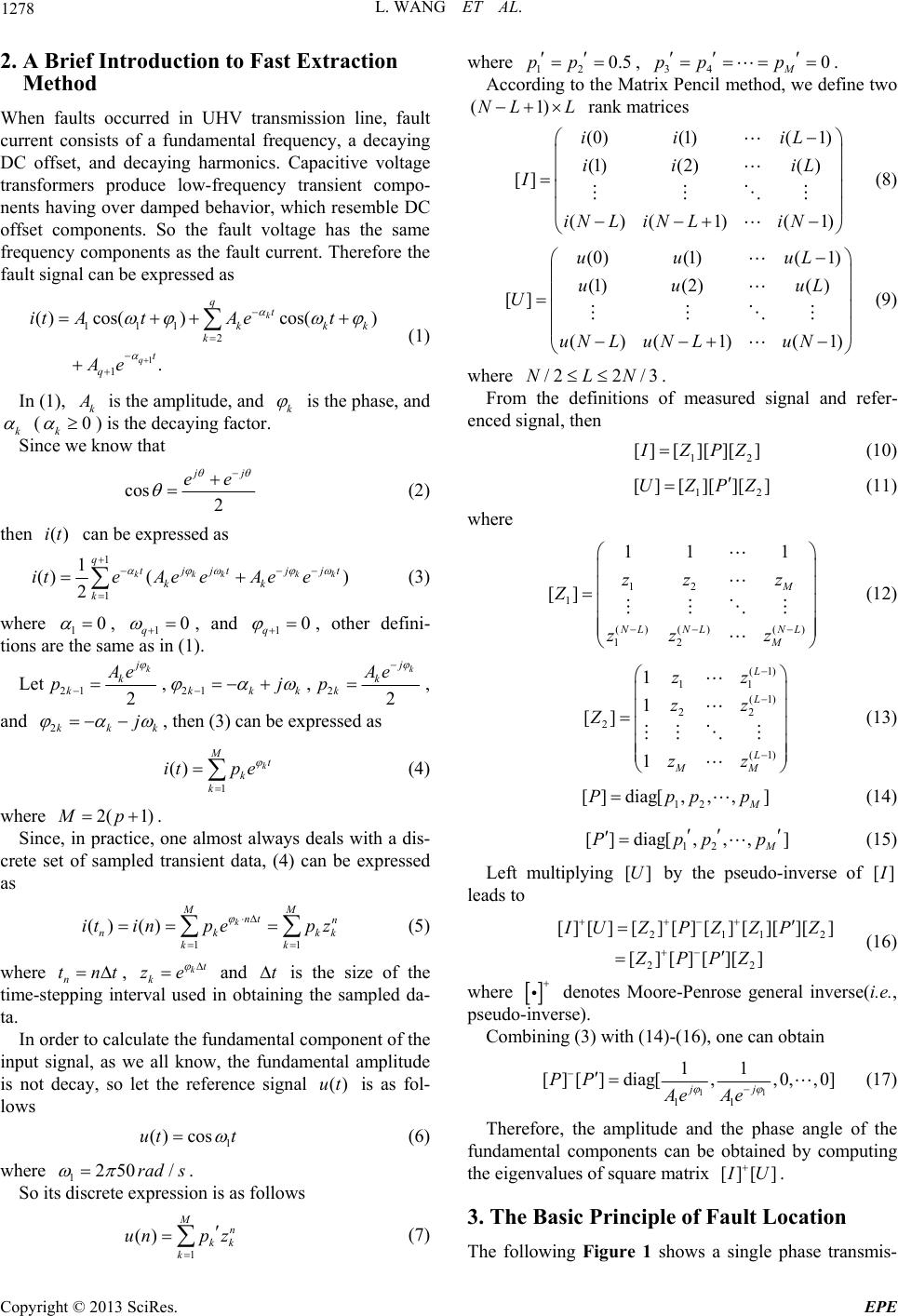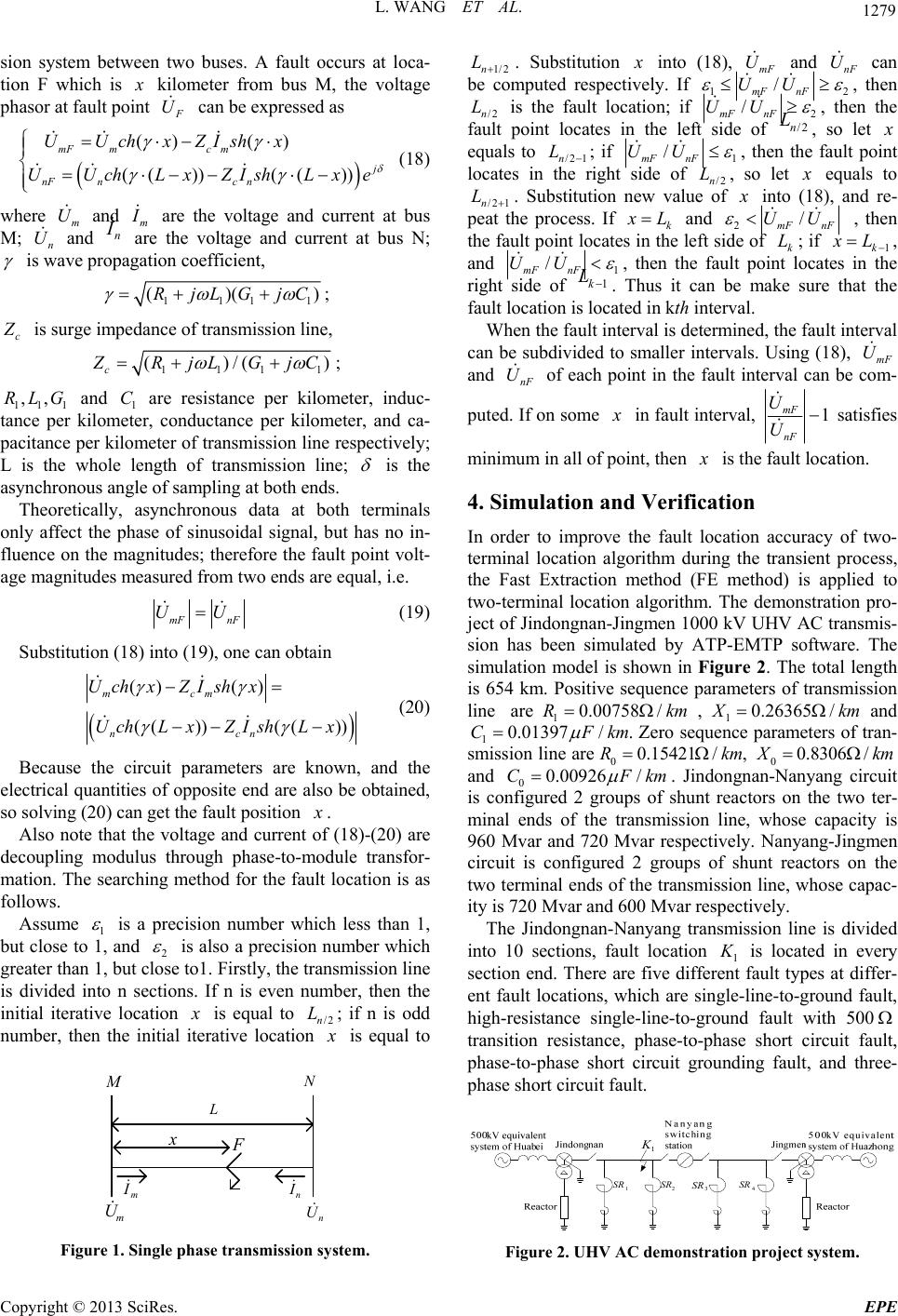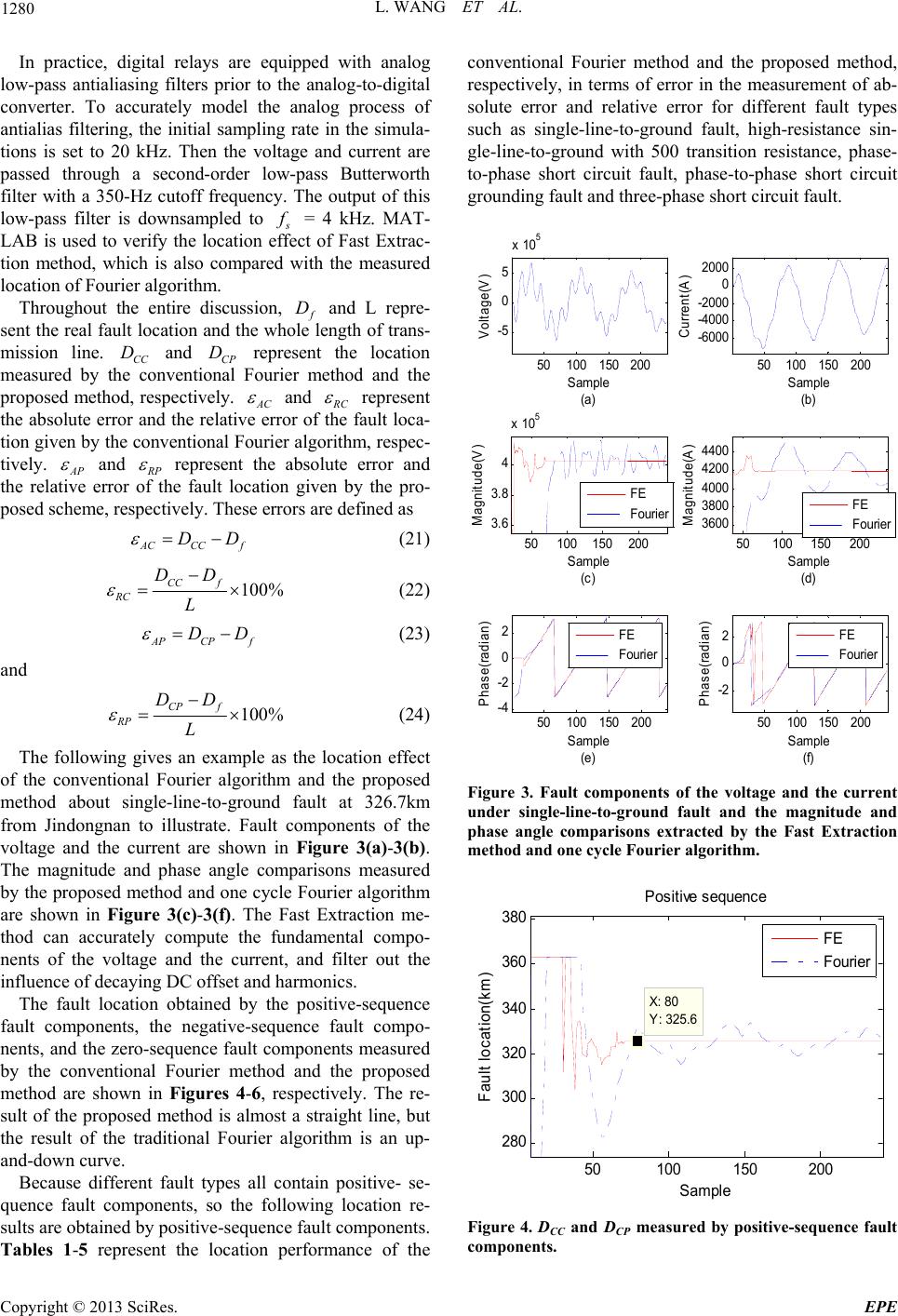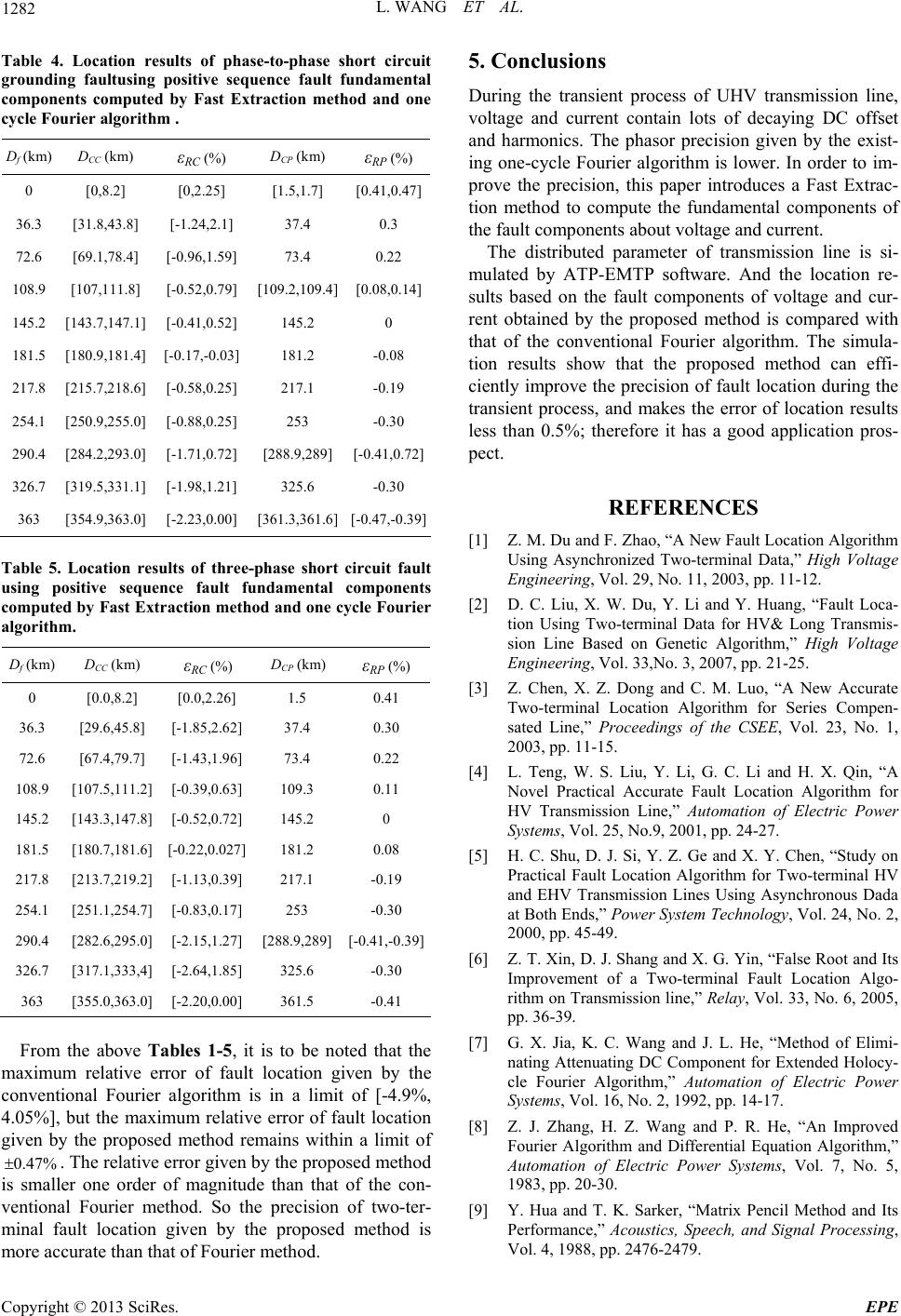Paper Menu >>
Journal Menu >>
 Energy and Power Engineering, 2013, 5, 1277-1283 doi:10.4236/epe.2013.54B242 Published Online July 2013 (http://www.scirp.org/journal/epe) A Fast Extraction Method in the Applicaton of UHV Transmission Line Fault Location* Li Wang1,2, Jiale Suonan1, Zaibin Jiao1 1Department of Electrical Engineering, Xi'an Jiaotong University, Xi’an, China 2Department of Technology Center , XJ Group Limited Company, Xuchang, China Email: xiesley_ann@163.com, suonan@263.net, jiaozaibin@mail.xjtu.edu.cn Received February, 2013 ABSTRACT To aim at the distribution parameter characteristics of UHV transmission line, this paper presents a fast extraction method (FE) to extract the accurate fundamentals of current and voltage from the UHV transmission line transient process, and locates the fault by utilizing two-end unsynchronized algorithm. The simulation result shows that this method has good performance of accuracy and stability, and has better location precision by comparing with results of one cycle Fourier algorithm. Therefore the method can efficiently improve the precision of fault location during the transient process, and makes the error of location results less than 0.5%. Keywords: UHV; Fast Extraction Method; Matrix Pencil; Transient Process; Fault Location 1. Introduction Recently, with the development of communication tech- nology and the improvement of electric power automa- tion system, two-terminal fault location method [1-6] has been gradually popularized in the power system. With the increasing of UHV long transmission line, two-ter- minal fault location method that employs the accurate distributed parameter model and need not synchronized data of two-terminal will be applied extensively. Com- pared with HV and EHV transmission line, UHV trans- mission line has the characteristics of large transmission capacity, long transmission distance, smaller wave im- pedance and larger distributed capacitance, so the fault transient process will be more complicated, and accu- rately acquiring of fault electric quantity would be diffi- cult. Most of existing location algorithms based on pha- sor method. In the transient process of UHV AC trans- mission system, the decaying DC offset of fault current and the decaying DC offset of fault voltage introduced by CVT extend the convergence time of the traditio nal Fou- rier algorithm, decrease the accuracy of algorithm, and also reduce the precision of electric quantities in the fau lt transient process. In order to remove the influence of decaying DC offset, many domestic and foreign scholars have proposed some improved algorithms, such as difference Fourier algo- rithm[7] and parallel compensatio n method [8]. Although difference Fourier algorithm can suppress the DC offset in a certain extent, it cannot remove the decaying DC offset; meanwhile it also amplifies the content of har- monics. Parallel compensation method required the prior knowledge regarding the time constant of the DC offset, so it is difficult to realize in practical engineering . On the premise of relay protection rapid action, the present algo- rithm has a high demand of rapidity, which will sacrifice some accuracy and stability. But the UHV transmission line require not only th e higher accuracy of fault location, but also protection quick trip over ten milliseconds, then the voltage and current data window would less th an one cycle. In order to calculate fault location fast and accu- rately, it is important to introduce a new phasor extrac- tion algorithm. Based on Matrix Pencil method [9-12], the Fast Ex- traction method [13] is established by using matrix simi- lar transformation and QR Factorization. It can quickly extract the fundamental frequency component of UHV transmission line, and remove the effect of decaying DC offset and high order harmonic component of the tran- sient process. This paper uses the Fast Extraction method to identify the fundamental component of fault compo- nent within 20 ms, and applies the fundamental to two-terminal fault location scheme for fault location, which greatly improves the accuracy of fault location during transient process, and has a good application prospect. *The research presented in this paper is supported by National Natural Science Foundation of China (51037005) and Specialized Research Fund for the Doctoral Program of Higher Education (2011020111 0056). Copyright © 2013 SciRes. EPE  L. WANG ET AL. 1278 2. A Brief Introduction to Fast Extraction Method When faults occurred in UHV transmission line, fault current consists of a fundamental frequency, a decaying DC offset, and decaying harmonics. Capacitive voltage transformers produce low-frequency transient compo- nents having over damped behavior, which resemble DC offset components. So the fault voltage has the same frequency components as the fault current. Therefore the fault signal can be expressed as 1 111 2 1 () cos()cos() . k q q t kk k t q it AtAet Ae k (1) In (1), k A is the amplitude, and k is the phase, and k (0 k ) is the decaying factor. Since we know that cos 2 j j ee (2) then can be expressed as ()it 1 1 1 () () 2kkk k q tjjt jjt kk k iteAeeAee k (3) where 10 , 10 q , and 10 q , other defini- tions are the same as in (1). Let 21 2 k j k k A e p ,21kk jk ,22 k j k k Ae p , and 2kk jk , then (3) can be expressed as 1 () k Mt k k it pe (4) where . 2( 1)Mp Since, in practice, one almost always deals with a dis- crete set of sampled transient data, (4) can be expressed as 11 () ()k MM nt n nk kk it inpepz kk t (5) where n, and is the size of the time-stepping interval used in obtaining the sampled da- ta. tn kt k ze t In order to calculate the fundamental component of the input signal, as we all know, the fundamental amplitude is not decay, so let the reference signal is as fol- lows ()ut 1 () cosut t (6) where 1250 /rad s . So its discrete expression is as follows (7) where , Acco 1 () Mn kk k unp z 12 0.5pp rding to the Ma3 pp p trix Penc 40 M. il method, we define two (1)NL L rank mtrices (8) (9) where a (0)(1)( 1) (1) (2) ii iL ii ( ) [] ()(1) (1) iL I iN LiN LiN (0)(1)( 1) (1)(2)( ) [] ()( 1)(1) uu uL uu uL U uN LuN LuN /22 /3NLN . From the definitions of measured signal and refer- hen enced signal, t 12 [][][ ][] I ZPZ (10) 12 [][][][]UZPZ (11) where (12) (13) 12 1 () ()() 12 11 [] M NL NLNL M zz z Z zz z 1 (1) 11 (1) 22 2 (1) 1 1 [] 1 L L L MM zz zz Z zz 12 [] diag[,,,] M Pppp (14) (15) Left multiplying by the pseudo 12 []diag[,,,] M Pppp []U -inverse of [] I leads to 2112 [][]][ ][][][][] 22 [ [][][][] I UZPZZPZ (1) ZP PZ 6 where o-invedenotes Moore-Penrose general inv pseudrse). bining erse(i.e., Com (3) with (14)-(16), one can obtain 11 11 ] diag[,,0,,0] (17) Therefore, the amplitude and the phase angl fundamental components can be obtained by co the eige 11 [][PP jj Ae Ae e of the mputing nvalues of square matrix [][ ] I U 3. The Basic Principle of Fault Location . The following Figure 1 shows a single phase transmis- Copyright © 2013 SciRes. EPE  L. WANG ET AL. 1279 sion system between two buses. A fault occurs at loca- tion F which is x kilometer from bus M, the voltage phasor at fault point F U can be expressed as ) () (( ))(()) mFmc m ( j nFnc ne UUchxZIshx UUch LxZIsh Lx (18) where and m U m I are the voltage and current M; d at bus n anU n I are the voltage and current at bus N; is w propagion coefficient, aveat 1111 ()()RjLGjC ; c Z is surge impedance of transmission line, 1111c()/() Z RjLGjC - r kiloter, conductance per kilomr, and ca- ; 11 1 ,,R tance pe pacitance per kilo LG and C are resistance per kilometer, induc 1 me ete meter of transmission line respectively; L is the whole length of transmission line; is the asynchronous angle of sampling at both ends. Theoretically, asynchronous data at both terminals only affect the phase of sinusoidal signal, but has no in- fluence on the magnitudes; therefore the fault point volt- age magnitudes measured from two ends are equal, i.e. mF nF UU (19) Substitution (18) into (19), one can obtain () () (( ))(( )) nc n Uch xZIshx UchLxZIshLx (20) Because the circuit parameters are known electrical quantities of opposite end are also be obtained, so mcm , and the solving (20) can get the fault position x . Also note that the voltage and current of (18)-(20) are decoupling modulus through phase-to-module transfor- mation. The searching method for the fault location is as follows. Assume 1 is a precision number which less than 1, but close to 1, and 2 is also a precision number which greater than but close to1. Firstly, the transmission line is divided into n sections. If n is even number, then the initial iterative location 1, x is equal to /2n L; if n is odd number, then the initial iterative location x is equal to F x L m I n I n U m U M N Figure 1. Single phase transmission system. . Substitution 1/2n L x into (18), and can puted re. If mF U nF U be comspectively 12 / mF UU nF , then is the fault location; if /2n L 2 / mF nF UU he point locates in the left side of , then t , so letfault /2n L x equals to /2 1n L ; if 1 / mF nF UU , thee fa e right side of , so let n thult point locates in th/2n L x equals to /2 1n L . Substitution new value of x into (18), and re- peat the process. If k x L and 2/ mF nF UU f L , then the fault point locates in the left sidek; if 1k o x L , and 1 / mF nF UU , then the fault in the right side of 1k Lpoint locates . Thus it care that the fault location is located in kth interval. When the fault interined, the fault interval can be subdivided to smaller intervals. Using (18), mF U and nF U of each point in the fault interval can be com- puted. If on some n be ma val is determ ke su x in faval,ult inter 1 mF nF U Uatisfies minioint, then s mum in all of p x is the fault location. 4. Simulation and Verification In order to improve the fault location accuracy of two- termil location algorithm during the transient process, the Fast Extraction method (FE methos applied to na d) i emonstra ject of Jindongnan- Jingmen 1000 kV UHV AC transmis- he simulation model is shown in Figure 2. The total length s of transmission two-terminal location algorithm. The dtion pro- sion has been simulated by ATP-EMTP software. T is 654 km. Positive sequence parameter line are0.00758 /Rkm 1 ,0.26 1365 / X kmand 10.01397/ .CFkm Zero sequence parameters of tran- smission line are 00.15421 /,Rkm 00.8306 / X km and 00.00926 /CFkm . Jindongnan-Nanyang circuit is configured 2 groups of shunt reactors on the two ter- minal ends of the transmission line, whose capacity is 960 Mvar and 720 Mvar respectively. Nanyang-Jingmen circuit is configured 2 groups of shunt reactors on the two terminal ends of the transmission line, whose capac- ity is 720 re nyang transmission line is divided into 10 sections, 1 Mvar and 600 Mvar spectively. The Jindongnan-Na fault location K is located in every section end. There are five different fault types at differ- ent fault locations, which are single-line-to-ground fault, high-resistance single-line-to-ground fault with 500 transition resistance, phase-to-phase short circuit fault, phase-to-phase short circuit grounding fault, and three- phase short circuit fault. 1 K 1 SR 2 SR 3 SR 4 SR Figure 2. UHV AC demonstration project system. Copyright © 2013 SciRes. EPE  L. WANG ET AL. 1280 In practice, digital relays are equipped with analog low-pass antialiasing filters prior to the analog-to-digital onverter. To accurately model the analog process of antialias filtering, the initial sampling rate in the simula- tions is set to 20 kHz. Then the voltage and current are passed through a second-order low-pass Butterworth filter with a 350-Hz cutoff frequency. The output of this low-pass filter is downsampled to c s f = 4 kHz. MAT- LAB tio is used to verify the location effect of Fast Extrac- n method, which is also compared with the measured location of Fourier algorithm. Throughout the entire discussion, f D and L repre- sent the real fault location and the whole length of trans- mission line. CC D and CP D represent the location measured by the conventional Fourier method and the proposed method, respectively. AC and R C represent the absolute error and the relative error of the fault loca- tion given by the conventional Fourier algorithm, respec- tively. AP and R P represent the absolute error and the relative error of the fault location given by the pro- posed scheme, respectively. These errors are defined as AC CC f DD (21) 100% CC f RC DD L (22) AP CP f DD (23) and 100% CPf RP DD L (24) The following gives an examp of the conventional Fourier algorithm and the proposed method about single-line-to-ground from Jindongnan to illustrate. Fault components of the voltage and the current are show magnitude and phase angle comparisons measured e proposed method and one cycle Fourier algorithm are shown in Figure 3(c)-3(f). The F thod can accurately compute the fundamental c ne t fault, phase-to-phase short circuit gr le as the location effect fault at 326.7km n in Figure 3(a)-3(b). The by thast Extraction me- ompo- nts of the voltage and the current, and filter out the influenc e of decaying DC offset and ha rmonics. The fault location obtained by the positive-sequence fault components, the negative-sequence fault compo- nents, and the zero-sequence fault components measured by the conventional Fourier method and the proposed method are shown in Figures 4-6, respectively. The re- sult of the proposed method is almost a straight line, but the result of the traditional Fourier algorithm is an up- and-down curve. Because different fault types all contain positive- se- quence fault components, so the following location re- sults are obtained by positive-sequence fault components. Tables 1-5 represent the location performance of the conventional Fourier method and the proposed method, respectively, in terms of error in the measurement of ab- solute error and relative error for different fault types such as single-line-to-ground fault, high-resistance sin- gle-line-to-ground with 500 transition resistance, phase- to-phase short circui ounding fault and three-phase short circuit fault. 50 100150 200 -5 0 5 x 10 5 Sample (a) Voltage(V) 50 100 150200 3.6 3.8 4 x 10 5 Sample (c) M agnitude( V) FE Fouri er 50 100 150 200 -4 -2 0 2 Sample (e) Phase(radian) FE Fourier 50100 150 200 -6000 -4000 -2000 0 2000 Sample (b) Current(A) 50 100 150 200 3600 3800 4000 4200 4400 Sample (d) Ma gnitude(A) FE Fouri er 50 100 150200 -2 0 2 Sample (f) Phase(radian) FE Fourier Figure 3. Fault components of the voltage and the current under single-line-to-ground fault and the magnitude and phase angle comparisons extracted by the Fast Extraction method and one cycle Fourier algorithm. 50100150200 280 300 320 340 360 380 Sample km) P ositi ve sequence FE Fourier Fault location( X: 80 Y: 325.6 Figure 4. DCC and DCP measured by positive-sequence fault components. Copyright © 2013 SciRes. EPE  L. WANG ET AL. 1281 Ta 2. Lesh sin- ground fault 50 100 150 200 260 280 300 320 340 360 380 X: 80 Y: 325.6 Sample Fault l oc ati on(k m) Negati ve sequenc e FE Fourier Figure 5. DCC and DCP measured by negative -sequence fau lt components. 50100150200 260 280 300 320 340 360 X: 80 Y: 326.8 Sample Fault location(km) Zero sequence FE Fourier Figure 6. DCC and DCP measured by zero-sequence faul able 1. Location results of single-line-to-ground fault using sequence fault fundamental components computed by Fast Extraction method and one cycle Fourier algorithm. Df (km) DCC (km) εRC (%) DCP (km) εRP (%) t components. T positive 0 [0.0,11.7] [0.00,3.22][1.30,1.60] [0.36,0.44] 36.3 [30.4,46.7] [-1.63,2.87][37.3,37.5] [0.28,0.33] 72.6 [65.0,84.0] [-2.09,3.14][73.2,73.5] [0.17,0.25] 108.9 [102.2,117.8] [-1.85,2.45][109.2,109.4] [0.08,0.14] 145.2 [140.3,151.3] [-1.35,1.68][145.2,145.3] [0.00,0.027] 181.5 [180.9,181.5] [-0.17,0.00][181.1,181.2] [-0.11,-0.08] [3] [3 [-] 217.8 [211.4,221.6] [-1.76,-1.05][217.1,217.1] [-0.19,-0.17] 254.1 [244.8,260.5] [-2.56,1.76][253.0,253.1] [-0.30,-0.28] 290.4 [278.8,297.9] [-3.20,2.07][288.9,289.0] [-0.41,-0.39] 326.7 [315.2,333.6] [-3.17,1.9] [325.4,325.6] [-0.36,-0.30] 363 49.9,363.0[-3.61,0.0]61.5,361.6]0.41,-0.39 bleocation r with 500 ults of higresistance gle-line-to using positive seque fundamenntt n method and one cycle Fourier algorithm. nce fault tal compoents compued by FasExtractio Df (km)DCC (km) εRC (%) DCP (km) εRP (%) 0 [0.00,17.9][0,4.93] [1.40,1.60] [0.39,0.44] 36.3 [34.4,51.0][-0.52,4.05] [37.3,37.6] [0.28,0.36] 72.6 [70.3,83.9][-0.63,3.11] [73.2,73.5] [0.17,0.25] [- 3.1] [-0.33,-0.28] [2][- [2] [-] 3[[-] [ [[ 108.9[105.7,116.8][-0.88,2.18] [109.2,109.3] [0.08,0.11] 145.2[141.8,149.9][-0.94,1.29] [145.2,145.3] [0.00,0.027] 181.5[181.1,181.3]0.11,-0.06] [181.1,181.2] [-0.11,-0.08] 217.8[212.4,220.4][-1.49,0.72] [217.0,217.1] [-0.22,-0.19] 254.1[245.7,256.6][-2.31,0.69] [252.9,25 290.478.6,291.93.25,0.41] 88.9,289.0 0.41,-0.39 26.7312.2,328.7]3.99,0.55325.4,325.7][-0.36,-0.28] 363 345.2,363.0][-4.90,0.00] 361.5,361.6][-0.41,-0.39] Tab shor fault using posiquel cts cethyr algorithm. ) le 3. Location results of phase-to-phaset circuit tive se d by Fast Exnce fault fundame raction metnta od and one componen cle Fourieomput Df (kmDCC (km) εRC (% ) DCP (km) εRP (%) 0 [0.0,9.2] [0,2.53] 1.5 0.41 36.3 [29.9,45.2] ] 3] 2 [141] 181.5 [180.8,181.5][-0.19,0.00] 181.2 -0.08 [2.][-9 [ [-1] 326.7 [312.8,332.8][-3.83,1.68] 325.6 -0.30 363 [354.2,363.0][-2.42,0.00] 361.5 -0.41 [-1.76,2.45]37.4 0.30 72.6 [67.6,79.3[-1.38,1.85]73.4 0.22 108.9 [106.4,112.[-0.69,0.94]109.3 0.11 145.3.3,147.[-0.52,0.52]145.2 0 217.8 [215.7,218.6][-0.58,0.22] 217.1 -0.19 254.1 [250.5,255.5][-0.99,0.39] 253 -0.30 290.4 835,294.41.0,1.10]288.9,289]0.4,-0.39 Copyright © 2013 SciRes. EPE  L. WANG ET AL. 1282 Tabu -to-phase shoruit grng puenlt funntal components computed byethod and one cy urim D) ) le 4. Locat oundi ion res faultusing lts of phase ositive seqt circ damece fau Fast Extract . ion m cle Foer algorith f (km) DCC (km) εRC (%) DCP (kmεRP (% 0 [0,8.2] [0,2.25] [1.5,1.7] [0.4.47]1,0 36.3 [31.8,43.8] [-1.24,2.1] 37.4 0.3 72.6 [69.1,78.4] [-0.96,1.59]73.4 0.22 108.9 [107,111.8] [-0.52,0.79][109.2,109.4] [0.08,0.14] 1 [1 1 [1[- 2 [2 254.1 [250.9,255.0] [-0.88,0.25]253 -0.30 45.2 43.7,147.1] [-0.41,0.52]145.2 0 81.5 80.9,181.4] 0.17,-0.03] 181.2 -0.08 17.8 15.7,218.6] [-0.58,0.25]217.1 -0.19 290.4 [284.2,293.0] [-1.71,0.72][288.9,289] [-0.41,0.72] 326.7 [319.5,331.1] [-1.98,1.21]325.6 -0.30 363 [354.9,363.0] [-2.23,0.00][361.3,361.6] [-0.47,-0.39] Lesulee-pht cirlt using positivequenco computed bExtrathod cy a hm D) D) ε Table 5.ocation rts of thrase shorcuit fau se y Fast e fault fundame ction mental c and onemponents cle Fourier lgorit. f (kmDCC (km) εRC (%) CP (kmRP (%) 0 [0.0,8.2] [0.0,2.26] 1.5 0.41 36.3 [29.6,45.8] [-1.85,2.62] 0. 254.1 [251.1,254.7] [-0.83,0.17] 253 -0.30 37.4 30 72.6 [67.4,79.7] [-1.43,1.96] 73.4 0.22 108.9 [107.5,111.2] [-0.39,0.63]109.3 0.11 145.2 [143.3,147.8] [-0.52,0.72]145.2 0 181.5 [180.7,181.6][-0.22,0.027]181.2 0.08 217.8 [213.7,219.2][-1.13,0.39]217.1 -0.19 290.4 [282.6,295.0][-2.15,1.27] [288.9,289] [-0.41,-0.39] 326.7 [317.1,333,4] [-2.64,1.85] 325.6 -0.30 363 [355.0,363.0] [-2.20,0.00] 361.5 -0.41 From the above Tables 1-5, it is to be noted that the mm errot lvee contioner aimit of% 4.05xime error of fault lo gi tedmaiithin a of T eby toposed method isleof m that of ton- ventete pon of t mahe ed med is more accurate than that of Fourier method. 5 c During tpHsmissne, voltage acof ing Dset and harmhsion thist- in-cr so prove thethtro Fastac- tioethuamompoof he fat comnrrent. mission Lines Using Asynchronous Dada at Both Ends,” Power System Technology, Vol. 24, No. 2, 2000, pp. 45-4 aximurelative r of faulocation gin by th , [ ven %], bual Fouri t the malgorithm is in um relativ a l [-4.9 cation [8] ven byhe propos method rens w limit 0.47%.he relativerror given he pr smal ionalr one order Fourier magnitude hod. So than th recisi he c wo-ter- [9] Y. Hua and T. K. Sarker, “Matrix Pencil Method and Its Performance,” Acoustics, Speech, and Signal Processing, Vol. 4, 1988, pp. 2476-2479. inal fult location given by tpropostho . Conlusions he transient rocess of UV tranion li nd current onics. The pontain lots asor precidecay given byC off e ex g oneycle Fouriealgorithm i lower. In rder to im- precision, is paper induces a Extr n m ul od to comp ponents ate the fund bout voltage aental c d cunents tThe distributed parameter of transmission line is si- mulated by ATP-EMTP software. And the location re- sults based on the fault components of voltage and cur- rent obtained by the proposed method is compared with that of the conventional Fourier algorithm. The simula- tion results show that the proposed method can effi- ciently improve the precision of fault location during the transient process, and makes the error of location results less than 0.5%; therefore it has a good application pros- pect. REFERENCES [1] Z. M. Du and F. Zhao, “A New Fault Location Algorithm Using Asynchronized Two-terminal Data,” High Voltage Engineering, Vol. 29, No. 11, 2003, pp. 11-12. [2] D. C. Liu, X. W. Du, Y. Li and Y. Huang, “Fault Loca- tion Using Two-terminal Data for HV& Long Transmis- sion Line Based on Genetic Algorithm,” High Voltage Engineering, Vol. 33,No. 3, 2007, pp. 21-25. [3] Z. Chen, X. Z. Dong and C. M. Luo, “A New Accurate Two-terminal Location Algorithm for Series Compen- sated Line,” Proceedings of the CSEE, Vol. 23, No. 1, 2003, pp. 11-15. [4] L. Teng, W. S. Liu, Y. Li, G. C. Li and H. X. Qin, “A Novel Practical Accurate Fault Location Algorithm for HV Transmission Line,” Automation of Electric Power Systems, Vol. 25, No.9, 2001, pp. 24-27. [5] H. C. Shu, D. J. Si, Y. Z. Ge and X. Y. Chen, “Study on Practical Fault Location Algorithm for Two-terminal HV and EHV Trans 9. [6] Z. T. Xin, D. J. Shang and X. G. Yin, “False Root and Its Improvement of a Two-terminal Fault Location Algo- rithm on Transmission line,” Relay, Vol. 33, No. 6, 2005, pp. 36-39. 7] G. X. Jia, K. C. Wang and J. L. He, “Method of Elimi- nating Attenuating DC Component for Extended Holocy- cle Fourier Algorithm,” Automation of Electric Power Systems, Vol. 16, No. 2, 1992, pp. 14-17. Z. J. Zhang, H. Z. Wang and P. R. He, “An Improved Fourier Algorithm and Differential Equation Algorithm,” Automation of Electric Power Systems, Vol. 7, No. 5, 1983, pp. 20-30. Copyright © 2013 SciRes. EPE  L. WANG ET AL. Copyright © 2013 SciRes. EPE 1283 Method for Es-[10] Y. Hua and T. K. Sarker, “Matrix Pencil timating Parameters of Exponentially Damped/ undamped sinusoids in Noise,” IEEE Transaction on Acoustics, Speech, and Signal Processing, Vol. 38, No. 5, 1990, pp. 814-824. doi:10.1109/29.56027 [11] Y. Hua and T. K. Sarker, “On SVD for Estimating Gen- eralized Eigenvalues of Singular Matrix Pencil in Noise,” IEEE Transaction on Signal Processing, Vol. 39, No. 4, 1991, pp. 892-900. doi:10.1109/78.80911 [12] T. K. Sarker and O. Pereira, “Using the Matrix Pencil Method to Estimate the Parameters of a Sum of Complex Exponentials,” IEEE Antennas and Propagation Maga- zine, Vol. 37, No. 1, 1995, pp. 48-55. doi:10.1109/74.370583 [13] J. L. Suonan, B. Wang, L. Wang, J. F. Sun and M. Xiao, “A Fast Phasor Estimator for Power System,” Proceed- ings of the CSEE, Vol. 33, No. 1, 2013, pp. 123-129. |

